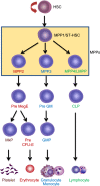New paradigms on hematopoietic stem cell differentiation
- PMID: 31201709
- PMCID: PMC6949320
- DOI: 10.1007/s13238-019-0633-0
New paradigms on hematopoietic stem cell differentiation
Abstract
Ever since hematopoietic stem cells (HSCs) were first identified half a century ago, their differentiation roadmap has been extensively studied. The classical model of hematopoiesis has long held as a dogma that HSCs reside at the top of a hierarchy in which HSCs possess self-renewal capacity and can progressively give rise to all blood lineage cells. However, over the past several years, with advances in single cell technologies, this developmental scheme has been challenged. In this review, we discuss the evidence supporting heterogeneity within HSC and progenitor populations as well as the hierarchical models revised by novel approaches mainly in mouse system. These evolving views provide further understanding of hematopoiesis and highlight the complexity of hematopoietic differentiation.
Keywords: differentiation; hematopoietic stem cell; heterogeneity; hierarchy.
Figures




References
-
- Adolfsson J, Mansson R, Buza-Vidas N, Hultquist A, Liuba K, Jensen CT, Bryder D, Yang L, Borge OJ, Thoren LA, et al. Identification of Flt3+ lympho-myeloid stem cells lacking erythro-megakaryocytic potential a revised road map for adult blood lineage commitment. Cell. 2005;121:295–306. - PubMed
-
- Akashi K, Traver D, Miyamoto T, Weissman IL. A clonogenic common myeloid progenitor that gives rise to all myeloid lineages. Nature. 2000;404:193–197. - PubMed
-
- Belyaev NN, Brown DE, Diaz AI, Rae A, Jarra W, Thompson J, Langhorne J, Potocnik AJ. Induction of an IL7-R(+)c-Kit(hi) myelolymphoid progenitor critically dependent on IFN-gamma signaling during acute malaria. Nat Immunol. 2010;11:477–485. - PubMed
-
- Benveniste P, Frelin C, Janmohamed S, Barbara M, Herrington R, Hyam D, Iscove NN. Intermediate-term hematopoietic stem cells with extended but time-limited reconstitution potential. Cell Stem Cell. 2010;6:48–58. - PubMed
-
- Benz C, Copley MR, Kent DG, Wohrer S, Cortes A, Aghaeepour N, Ma E, Mader H, Rowe K, Day C, et al. Hematopoietic stem cell subtypes expand differentially during development and display distinct lymphopoietic programs. Cell Stem Cell. 2012;10:273–283. - PubMed
Publication types
MeSH terms
LinkOut - more resources
Full Text Sources
Other Literature Sources
Medical
Miscellaneous

